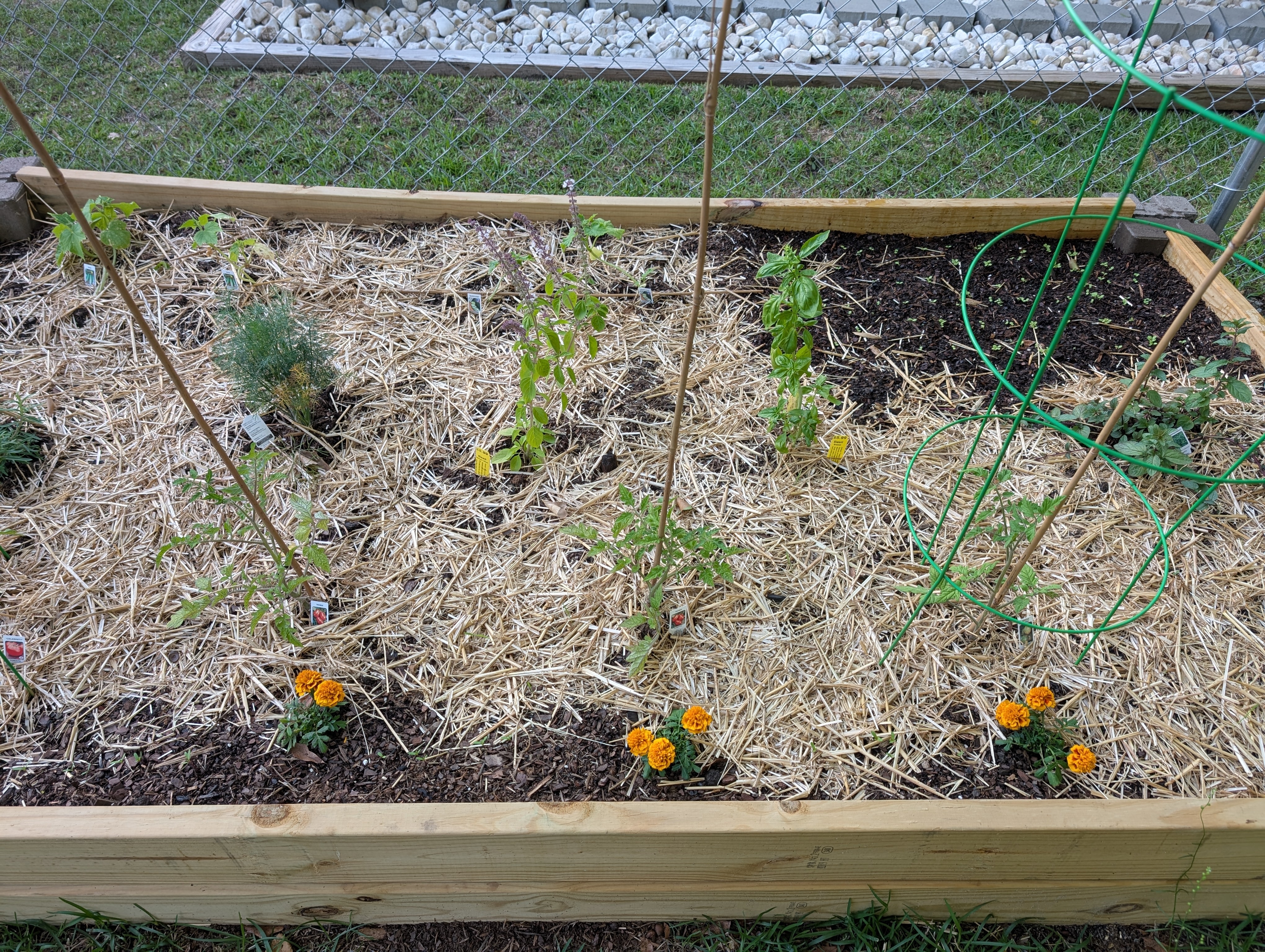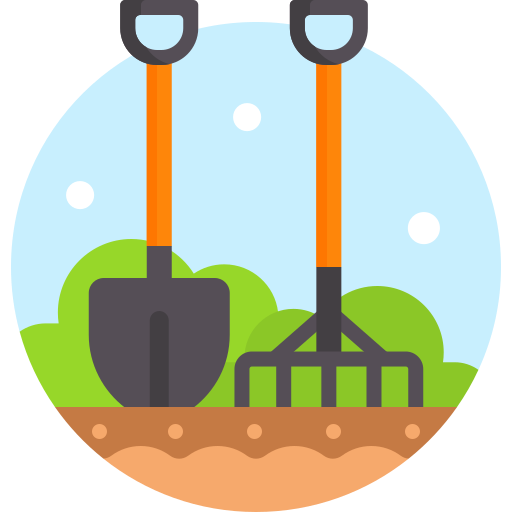I want to thank everyone who responded with advice for my last post.
Per the advice I received, I went ahead and found a 10-10-10 Scott’s fertilizer. I tried to apply it or the instructions, mixing it into the soil, and watered it in. I’m hoping for good things. One thing I’m curious about: the instructions indicate this particular product should be applied every two months, which seems like a long interval. Shouldn’t I be fertilizing more often? Did I choose the wrong kind?
Also, I finally got some straw and used it as mulch. It seems like it’s keeping the soil wetter for longer.
As for my plants: 
My potted tomato plant is taking off, more so than the ones I have in the actual bed. I installed a stake and a cage. I had primed of the first flower, but I believe it may be ready to bloom again. Do I need to keep trimming the flowers until it gets bigger?
 The onions I started later are taking off, too. I planted them as far apart as my instructions suggested, but I’m wondering if they need to be thinned out. The container is small, I know, but I’m hoping it’s just deep enough for them to succeed. I do worry if I’m keeping them too wet–the container is self-watering, so I’ve watered them less, but the soil is constantly moist. Will this be a problem later on?
The onions I started later are taking off, too. I planted them as far apart as my instructions suggested, but I’m wondering if they need to be thinned out. The container is small, I know, but I’m hoping it’s just deep enough for them to succeed. I do worry if I’m keeping them too wet–the container is self-watering, so I’ve watered them less, but the soil is constantly moist. Will this be a problem later on?
 My herbs (rosemary, dill, African and sweet basil, and peppermint) seem to be doing well. The African basil is flowering–do I need to cut these back for any reason?
My herbs (rosemary, dill, African and sweet basil, and peppermint) seem to be doing well. The African basil is flowering–do I need to cut these back for any reason?
My cucumbers are growing, but slowly. Three of them are definitely bigger, though one lags behind. I’m thinking the shallow depth of my bed is coming into play here. I wonder if I should try to transfer them to a deep pit like the one tomato I have already mentioned.
 The four tomato plants I have in the bed, determinate and semi-determinate, aren’t gaining a lot of height, but they do seem bushier. Again, I wonder if the shallowness of my bed is already holding them back. Stakes and cages are in place for the semi-determinate varieties, but I only have stakes for my two Roma plants.
The four tomato plants I have in the bed, determinate and semi-determinate, aren’t gaining a lot of height, but they do seem bushier. Again, I wonder if the shallowness of my bed is already holding them back. Stakes and cages are in place for the semi-determinate varieties, but I only have stakes for my two Roma plants.
 Here’s the peppermint I was warned would take over my bed given a chance. Do I need to go ahead and transfer it to a separate area or pot now?
Here’s the peppermint I was warned would take over my bed given a chance. Do I need to go ahead and transfer it to a separate area or pot now?
 My loose leaf lettuce seeds have sprouted, which is cool. I’m watching them closely to see how it grows. I didn’t fertilize these plants since they’re so young for fear of hurting them.
My loose leaf lettuce seeds have sprouted, which is cool. I’m watching them closely to see how it grows. I didn’t fertilize these plants since they’re so young for fear of hurting them.
Also, the marigold seeds I planted along the edges between the mature marigolds I planted have sprouted, as well.
 These pots are on the front side of my house. The small and medium size ones have more marigolds I planted from seed. I’m wondering if they’re getting big enough that I will need to thin them out.
These pots are on the front side of my house. The small and medium size ones have more marigolds I planted from seed. I’m wondering if they’re getting big enough that I will need to thin them out.
The big pot at the bottom has Shasta Daisies. They took a while to sprout, and are growing much more slowly than my other flowers.
 I’ve got two planters with Zinnias I sewed on my porch, and they’re really doing well. I’m wondering if and when I should think these too.
I’ve got two planters with Zinnias I sewed on my porch, and they’re really doing well. I’m wondering if and when I should think these too.
I appreciate any advice you guys may have as I progress. I’m trying to learn as much as I can, and you all have been an important part of my education so far.
If everyone is okay with it, I’ll continue to post updates. Thanks for your help!


Not at all true for the purposes of home gardening: https://extension.missouri.edu/publications/g9181. Granular fertilizer worked into the soil and covered by mulch isn’t going anywhere.
Entirely depends on the form of phosphate. See “Table 1: Percentages of water-soluble and available phosphate in several common fertilizer source”. The runoff bit is still nonsense.
https://extension.umn.edu/phosphorus-and-potassium/understanding-phosphorus-fertilizers#materials-619210
Sure - that buildup takes a while though.
I agree that it’s more complex than that, and early 3-1-2 is in no way a catastrophic death knell, but there’s a grain of truth to it. As I think we also agree, pretty much every reputable source will tell you to prep the bed with a higher P+K feed in the early season.
A nice attempt but you’ll have to dig deeper to understand how it works.
First off this is how phosphate contaminates waterways.
The soil particles holds the phosphorus in the top few inches of the profile. Then during saturation events, it dissolves runs off with the water.
It also can leach into groundwater but it’s not as common and depends on the chemical makeup of the soil type.
https://www.usgs.gov/special-topics/water-science-school/science/phosphorus-and-water#overview
This is why phosphorus in lawn fertilizer has been banned in many states.
1/3 of phosphorus is not available to plants at application - completely missed that one.
Plants only take up the ortho-phosphate. Water soluable phosphate is usually a blend of polyphosphate (2/3rd) and ortho-phosphate (1/3). Polyphosphate is converted to ortho-phosphate via hydrolysis in water. Depending on the composition of the soil temperatere, moisture, it can take a few days or a few weeks or months to convert.
K+ interfering with the uptake of Mg+ and Ca+.
K+ , Mg+ and Ca+ compete for uptake directly with K+. Any amount of excess K+ directly competes with the uptake of Mg+ and Ca+. This is why some species just uptake extra K+ and store it in their vacuoles. If you want to cause BER in tomatoes/peppers, watermelons etc… extra K can do this the first year. These species struggle to get enough Ca to the growing point under good conditions. Anything that slows it down can cause BER.